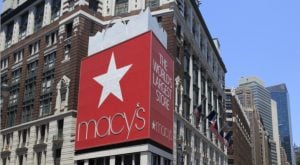Stocks started off the month of October on the wrong foot. Investors took one look at the month’s dreadful manufacturing numbers and hit the sell button on the S&P 500. With the trade war and impeachment headlines also circulating, it could be a bumpy ride for investors in the coming weeks and months.
This is a great time to play defense. And how better to do that than by picking up some high-quality dividend stocks?
Unfortunately, not all the market’s highest-yieldings dividend stocks are great buys; some look more like value traps. This guide will help you pick through the market’s beat-up dividend shares to find the best dividend income stocks for your portfolio.
Macy’s (M)
Dividend Yield: 10.6%

Macy’s (NYSE:M) is an iconic American name now offering a mouth-watering 10% dividend yield. But is M stock a safe buy today?
Macy’s has now fallen into the same value trap that has plagued so many retailers before it. You end up with one part of the shareholder base wanting the company liquidated for its real estate value. Another portion wants to keep running the retail operations while investing the minimum possible into the business while maximizing dividends. A third camp wants to slash the dividend and invest in the company heavily to keep the brand viable for the long-term.
Previous attempts to thread the needle and keep everyone happy have generally spectacularly failed. See Sears for the most prominent recent example, although there are many. If you own M stock for the long term, you have to be confident that the company can manage this challenge better than its peers.
Is there potentially a trade in M stock? Absolutely. The farther it drops, the more appealing it gets to activists, people trying to force short squeezes, and so on. But for long-term investors that want sustainable dividends, this isn’t the best play.
Macy’s best move – to make it a viable long-term business – would be to slash the dividend tomorrow to try to keep its business thriving in coming years. Doing so, however, would likely cause M’s stock price to tank. All the people buying for the 10% dividend yield would dump it tomorrow. For the time being, M stock seems oversold and you can probably make money trading it. Don’t buy it assuming the 10% dividend yield will last forever, though.
Macerich (MAC)
Dividend Yield: 10.46%

Many investors are rightfully skeptical of mall REITs. Lower-quality names in the sector have crashed, and people fear it’s only a matter of time until Macerich (NYSE:MAC) also has to cut its dividend. Is the panic justified?
Not necessarily. Unlike the low-end mall operators, Macerich owns some of the most desirable mall properties in the country. On average, it obtains substantially more sales per square foot than even Simon (NYSE:SPG) only trailing luxury operator Taubmann (NYSE:TCO) on that front. However, that hasn’t been enough to quiet the bears, who keep dumping MAC stock. They believe that the company is overly levered, and that if its balance sheet and coverage metrics look this shaky during a long economic expansion, things are sure to get much worse when a recession finally hits.
Unlike low-end malls, I’m not convinced that Macerich’s properties are largely obsolete in an e-commerce world. Sure, the suburban regional mall model is antiquated in the U.S., but large metro areas should still be able to support a few high-end places for elite brands like Apple (NASDAQ:AAPL), international flagship stores, experience-based opportunities, and so on. The loss of department stores will be a long-term drag for even elite malls; but Macerich has great properties and real estate to try to manage the transition.
At this point, MAC stock is down nearly two-thirds from its highs a few years ago. Notably, Simon tried to buy the company out for $91/share and it is now trading at just $30. The value of American malls has dropped a lot over the past five years, but even given that, this seems like an overreaction. There will be bumps along the way, but MAC stock at this price could be a winner for income investors.
Altria (MO)
Dividend Yield: 8.3%

I recently made the case for Altria (NYSE:MO) stock in my article describing the current situation with vaping. To make a long story short, the market is seriously overreacting in the case of Altria in particular.
Its combined investments in Juul and Cronos (NASDAQ:CRON) amount to less than $20 billion, or $10 per share of MO stock. Yet Altria stock has dropped more than $30 per share since its 2017 highs. Even if you value both Juul and Cronos at zero, the decline still seems significantly overblown. And there’s good reason to think that Juul especially, and quite possibly Cronos as well, will eventually bounce back.
In the meantime, Altria stock is yielding more than 8%. And the dividend is well-covered. Remember that Altria pays for the dividend almost entirely out of its cigarette operations. Juul and Cronos aren’t providing cash flow to Altria now, as it is, so if those investments fare worse than expected, it really doesn’t make a huge impact on the dividend in the near term. MO stock is a great defensive dividend pick here.
Philip Morris (PM)
Dividend Yield: 6.1%

Philip Morris (NYSE:PM) had seen its dividend yield rise dramatically in recent weeks as investors’ fears of everything tobacco-related have mushroomed. However, it appears that PM stock finally found a bottom. That’s because the company has announced that its potential merger with Altria is now off the table.
It’s unclear whether re-merging the firms would have produced sufficient cost savings and synergies to make a big difference. It is apparent, however, that vaping is absolutely toxic to valuations right now. So Philip Morris, by steering clear of any potential involvement in Juul, is now a much safer stock.
I think MO stock has more upside as the vaping concerns seem overblown. But if you are worried about more bad headlines out of field, then Philip Morris is a fine alternative. The PM stock’s 6.1% dividend yield is quite compelling in its own right.
Iron Mountain (IRM)
Dividend Yield: 7.54%

File storage and data security REIT Iron Mountain (NYSE:IRM) appears to be a classic value trap. The dividend yield of 7.54% certainly is appealing. However, the REIT appears to be in a slowly shrinking industry and efforts to go digital are not producing enough tangible results yet.
The company’s debt is rated BB-. That’s well into junk bond territory. Unlike many REITs, there’s not nearly as much hard real estate asset value here as you might expect. Meanwhile, the ever-growing presence of digital record-keeping is whittling away demand for Iron Mountain’s paper storage solutions. As a result, its business in developed markets is now starting to shrink. The company has plans to pivot to data centers, however it is several steps behind other REITs in building out its capabilities there.
With the huge debt load and questions around its core business, IRM stock is a pass. Yes, that dividend yield is huge. But there’s not a lot of certainty about how long it will last.
Occidental Petroleum (OXY)
Dividend Yield: 7.37%

I personally am steering clear of Occidental (NYSE:OXY) stock following the Anadarko merger. Obviously, traders have absolutely pounded Occidental’s stock, and there might be room for some recovery. But Occidental seems to have a clear case of the Winner’s Curse. That is when someone bids too much at an auction, wins the prize, but ends up suffering as a result.
Consider that Occidental outbid Chevron (NYSE:CVX) by $5 billion to secure Anadarko. In paying such a steep price, given Occidental’s relatively smaller size, it had to take on a lot of high-priced debt from Berkshire Hathaway (NYSE:BRK.B) while also selling off nearly $9 billion assets to Total (NYSE:TOT).
How much are you willing to give up in terms of total returns, future dividend growth, and balance sheet quality to get a little more yield today? That’s the question with OXY stock now.
Few would disagree with the idea that Chevron, Total, and ExxonMobil (NYSE:XOM) are higher-quality firms with better management teams and balance sheets than Occidental. OXY stock is yielding 7.37%. XOM stock is yielding about 5%. Are you willing to buy a far smaller/more leveraged up company with a management team that just finished making what seems like a major blunder to get an extra 2% of dividend yield? I’m not.
Ford (F)
Dividend Yield: 6.99%
Ford (NYSE:F) offers an almost 7% dividend yield and is now the highest-yielding traditional industrial firm in S&P 500 yields, as its yield recently topped Dow Inc’s (NYSE:DOW). Right now, people are bearish on the economy in general and the auto cycle in particular. There’s appeal to buying Ford stock for a trade. I wouldn’t be surprised if F stock pops back over $10 while offering its 7% annual yield.
That’s not a bad short-term trade. Long-term, however, autos have historically been a poor sector for investors. Even in the best of times, they require tons of capital to produce modest profits. With the trade war hitting demand for now and the evolution to EVs presenting a challenge over the longer-haul, Ford stock remains one that’s better suited for traders than long-term investors.
Dow Inc. (DOW)
Dividend Yield: 6.09%

Speaking of Dow, it also makes the list. With the recent DowDupont merger and subsequent spin-offs, management intended to create a more yield-centered play for income investors. And with Dow, they’ve accomplished that, particularly since Dow’s stock price continues to slump, pushing the yield up ever farther.
The new standalone Dow is focused on petrochemical products. This is a highly profitable but low-growth business; in fact, revenues are shrinking a bit at the moment. Additionally, there’s more uncertainty than usual around forward numbers because we haven’t seen Dow, as this combination of standalone businesses, go through a downturn before. That’s why some analysts are skeptical of DOW stock’s yield.
Dow stock is cheap and the yield is attractive, but I’m not 100% convinced that the dividend holds through the next recession. And there are a ton of chemical stocks under 10x earnings with sizable dividend yields at the moment. DOW stock is worth looking at now, but you might be able to get it even cheaper with a little patience.
Schlumberger (SLB)
Dividend Yield: 6.27%

Ben Graham is known as the “Father of Value Investing.” People often cite his work as a reason to only buy the absolute cheapest stocks out there.
But that was far from the only tool in his arsenal. Another approach he liked was to buy the industry leader – assuming it had a good balance sheet – in a struggling sector. His thinking being that you were sure the firm would survive because of its leadership position, and that it might be able to gain competitively as other firms go bust or have to sell assets.
Oil services will eventually have another bull market, and Schlumberger (NYSE:SLB) will be a big part of it when it does. With its AA- credit rating, in fact, it’s one of the strongest companies globally in the energy industry. The only knock on SLB stock, as a yield play, is that they may cut the dividend at some point to keep the balance sheet strong if industry metrics don’t improve soon.
But, sooner or later, SLB stock will fly again. As it is, shares are much cheaper than they were even in 2016 when oil briefly fell to less than $30/barrel; Schlumberger bottomed around $60 per share back then and is down to the low $30s now, despite remaining profitable in the interim. The market is giving away SLB stock down at these prices.
AbbVie (ABBV)
Dividend Yield: 5.84%

Rounding out the list of high-yielding S&P 500 stocks, we have pharma company AbbVie (NASDAQ:ABBV). The company is a spinoff from long-time leading health care and medical devices company Abbott (NYSE:ABT). Unfortunately, AbbVie has had a more checkered run.
ABBV relies on its Humira drug for nearly two-thirds of revenues, but could lose most of those over the next few years as Humira loses patent protection. To deal with that, AbbVie has made a series of increasingly risky M&A deals, most recently buying Allergan — a pharma rollup that was notable for its involvement in the Valeant saga. AbbVie just spent more than $60 billion on Allergan to try to fill its upcoming Humira revenue hole.
In any case, AbbVie appears to have drawn a ton of investor interest primarily for its outsized dividend. If ABBV stock were yielding 2-3% like other health care companies, it’d get far less attention. But because it yields about 6%, it draws a ton of interest from people that don’t follow the sector closely.
To which I’d say, beware of why this is yielding so much. Drug companies, generally, shouldn’t pay such a high dividend because they have to reinvest so much in R&D. When you have a high yield from this sector, it’s often because the company’s big drug products are going off patent. Yield-seeking investors are attracted to the cash flow off a peak drug, while more long-horizon investors fret about what happens after you fall off the patent cliff.
In the case of AbbVie, I’ve seen little evidence that the company will be able to replace its current profits after the next couple of years. The Allergan deal looks like a risky and desperate measure.
At the time of this writing, Ian Bezek owned shares of XOM, MO, SLB, DOW, and BRK.B. You can reach him on Twitter at @irbezek.

